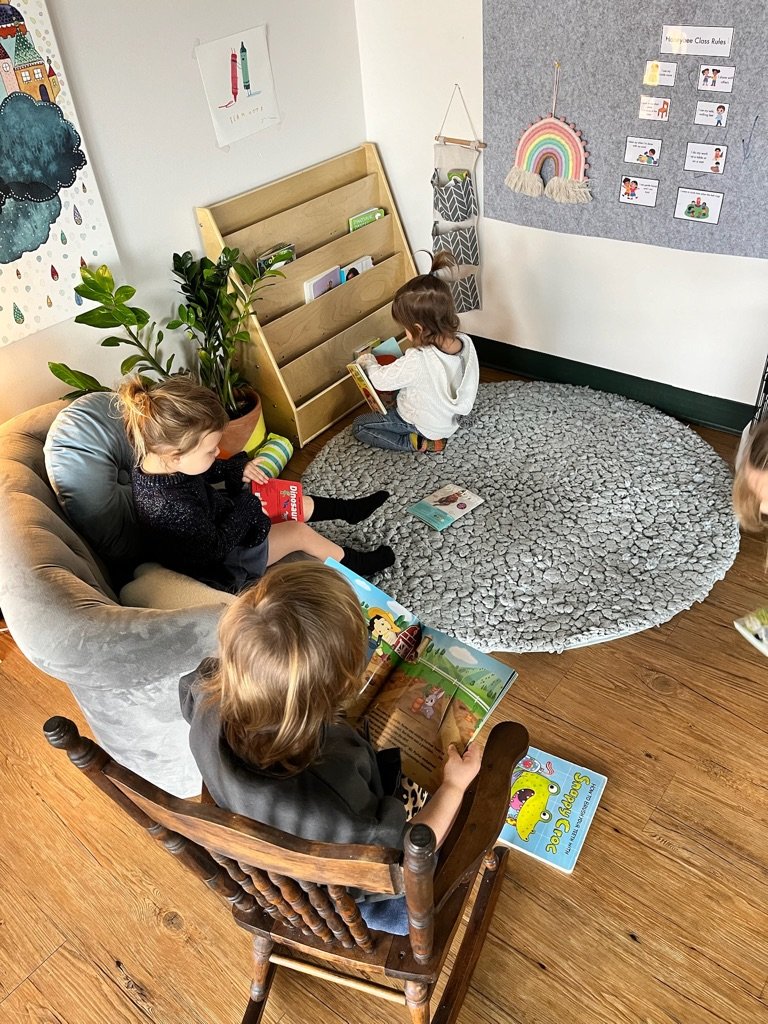Toddler Program
Half Day: 9 a.m.- 12 p.m.
Our half-day toddler program is for children 18 months to three years old.
The very basics of our Montessori program begin in the toddler classroom: learning to belong to an environment outside of the home (although it sure does feel like home), how to keep track of one’s belongings, and the beginnings of independence from taking turns, making food, and learning all about the toileting process. Children develop strong bonds with their caregivers and other friends in the classroom and build confidence.
A typical day in our toddler program begins with a morning greeting, putting away belongings, changing out of shoes, and finding a lesson from the shelves to work on.
Once students settle into the classroom routine, they have an hour and a half to explore all of the classroom's treasures independently or with their friends and teachers. There is also time for a snack and group time at our circle rug. Group time consists of singing and movement to music. At this age, group time is optional for children.
Practical Life
A large part of the toddler program is practical life, from practicing dressing and undressing themselves independently, to baking bread and caring for the classroom as a community. They are learning to wash tables, sweep the floors, and polish plants, just to name a few. These lessons build a child’s confidence, excitement, and enthusiasm to learn more and show them that a family and community take teamwork and responsibility. Everything we do has a practical reason as to WHY we do it. Toddlers must feel that there is a reason behind their efforts and take much pride in participating in the process.
Education for the Senses
Within the classroom, the children will naturally encounter many different textures and sensory experiences. The wet water in dishwashing, the soft polishing cloth used for wood polishing, the hard brass they clean, the plush rug in the peace corner, and education for the senses are naturally built into their daily experience.
Math
While numeracy is not primarily focused on at this level, math is everywhere. We see it in keeping time and rhythm in our music, learning how to do tasks with order and sequence, and counting out loud when the opportunities present themselves. Our sensorimotor materials allow children to learn and develop problem-solving skills, spatial awareness, and shapes.
Language
Language is intertwined in all we do, from categorizing types of animals to discovering the different names of utensils we use. Our pre-language shelves contain concrete materials that allow children to explore models and pictures. Beginning with items and animals they see in their immediate surroundings, and then discovering new ones they may not have seen before. We slowly move from concrete to more abstract through the year and watch their vocabulary build! We also focus on their communication and understanding through story-telling and “sportscasting,” giving them a running anecdote of what we see, and soon they put all the pieces together themselves. Your child will grow into a little storyteller and start to understand how their body and movements affect the world around them.
Social Studies
Our primary way of implementing social studies and societal roles at this age is through our community within the classroom. Everyone has a role to play in keeping our room clean, safe, happy and thriving. From washing dishes and folding clean laundry, to comforting those who are upset and making sure all of us are welcome and feel included, we also talk about roles outside of our classroom, like the doctors and nurses who help us feel better and the police officers and firefighters who keep us safe.
Science
Most of the toddlers' experiences with science happen in our cooking and baking lessons. We watch our dough rise, we see the heat turn it into fluffy bread, and we see the steam coming from the freshly cut slices. This is just one example of the many opportunities to watch chemical reactions happen!
Art
Toddlers love to be messy! And art is the perfect way for their desires to flow naturally. They are presented with different materials and mediums to use as they please. Parents won’t see those special projects you may find in an older classroom coming home yet. At this developmental stage, children don’t want to sit still and follow along with a step-by-step process because they can’t quite grasp that the end product will be the example in front of them. Instead, we let them explore the textures and sensations that chalk, paint, crayons, and clay bring.







